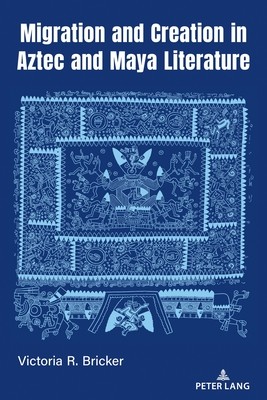
- We will send in 10–14 business days.
- Publisher: Peter Lang Inc., International Academic Publishers
- ISBN-10: 1433198673
- ISBN-13: 9781433198670
- Format: 15.2 x 22.9 x 0.8 cm, minkšti viršeliai
- Language: English
- SAVE -10% with code: EXTRA
Migration and Creation in Aztec and Maya Literature (e-book) (used book) | bookbook.eu
Reviews
Description
Migration and Creation in Aztec and Maya Literature provides a new perspective on migration and creation episodes in the Popol Vuh of the Quiché Maya Indians of highland Guatemala, demonstrating that they are largely borrowed from Aztec sources. These findings upend previous interpretations resulting from the widely held belief that the Popol Vuh is the most "authentic" Maya book. Victoria Bricker's careful historical analysis explains the origin of these borrowings, which stemmed from the expansion of the Aztec empire southward from the Central Valley of Mexico into the highlands of what is today the Mexican state of Chiapas and continuing into highland Guatemala as far south as the town of Utatlan, whose rulers then intermarried with members of the Aztec royal family.
This innovative volume explores new ground, comparing Aztec pictorial representations of migration with Maya written descriptions of the same events and showing that they have much in common. Bricker's exploration of creation narratives demonstrates that the Aztec treatment of multiple creations is more coherent than the Popol Vuh version because it describes the end of each creation before embarking on a new creation, whereas the Popol Vuh version refers to the end of all creations only once. Bricker also provides a new interpretation of creation texts from the archaeological sites of Quirigua and Palenque that challenges models suggesting that the Precolumbian Maya, like the Aztec, believed in multiple creations. Students of Latin American history will find fresh insights regarding interactions and cultural contact in Late Prehispanic Mesoamerica in Bricker's study.
EXTRA 10 % discount with code: EXTRA
The promotion ends in 21d.17:39:48
The discount code is valid when purchasing from 10 €. Discounts do not stack.
- Publisher: Peter Lang Inc., International Academic Publishers
- ISBN-10: 1433198673
- ISBN-13: 9781433198670
- Format: 15.2 x 22.9 x 0.8 cm, minkšti viršeliai
- Language: English English
Migration and Creation in Aztec and Maya Literature provides a new perspective on migration and creation episodes in the Popol Vuh of the Quiché Maya Indians of highland Guatemala, demonstrating that they are largely borrowed from Aztec sources. These findings upend previous interpretations resulting from the widely held belief that the Popol Vuh is the most "authentic" Maya book. Victoria Bricker's careful historical analysis explains the origin of these borrowings, which stemmed from the expansion of the Aztec empire southward from the Central Valley of Mexico into the highlands of what is today the Mexican state of Chiapas and continuing into highland Guatemala as far south as the town of Utatlan, whose rulers then intermarried with members of the Aztec royal family.
This innovative volume explores new ground, comparing Aztec pictorial representations of migration with Maya written descriptions of the same events and showing that they have much in common. Bricker's exploration of creation narratives demonstrates that the Aztec treatment of multiple creations is more coherent than the Popol Vuh version because it describes the end of each creation before embarking on a new creation, whereas the Popol Vuh version refers to the end of all creations only once. Bricker also provides a new interpretation of creation texts from the archaeological sites of Quirigua and Palenque that challenges models suggesting that the Precolumbian Maya, like the Aztec, believed in multiple creations. Students of Latin American history will find fresh insights regarding interactions and cultural contact in Late Prehispanic Mesoamerica in Bricker's study.


Reviews